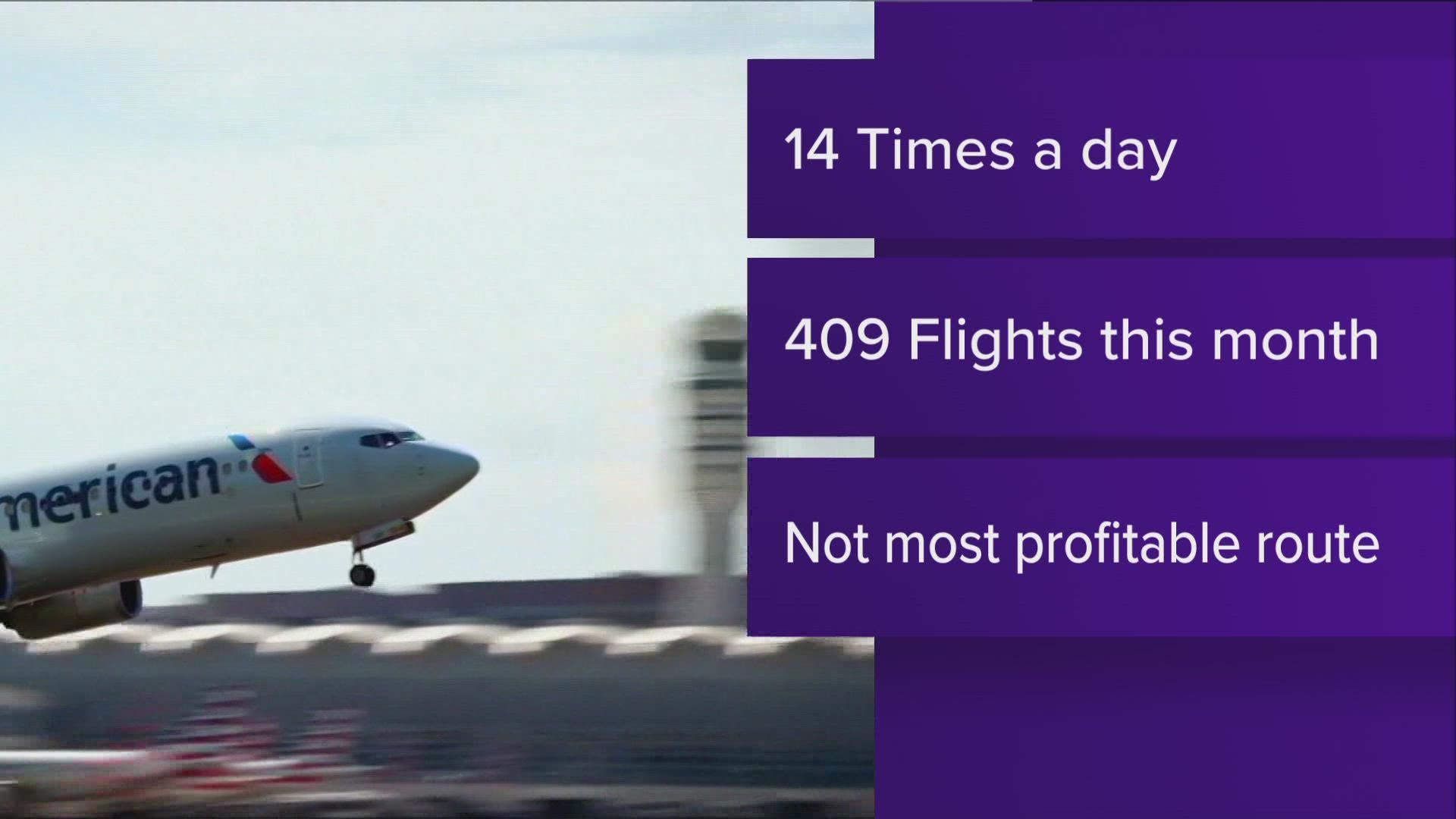DALLAS — Read this story in WFAA news partner the Dallas Business Journal.
American Airlines Group Inc. operates more flights to Austin from Dallas-Fort Worth International Airport than any other destination even though it may not be the most profitable route, according to flight data tracker Cirium.
Fort Worth-based American (Nasdaq: AAL) serves Austin 14 times a day and this month is scheduled to operate 409 flights from DFW to the Texas capital. Despite the segment's frequency, Cirium ranks it in the bottom quartile of all routes within American's network for profitability.
Network planners, analysts and consultants historically have used metrics like load factor and yield to gauge the profitability of a route. Cirium's new "Route Grader" tool rates flight segments by taking into account ancillary and cargo revenue as well to determine overall performance.
According to Cirium, the Austin-DFW segment had one of the lowest load factors at 63% in the first quarter, meaning flights are almost two-thirds full. Yield for the segment is 37.6 cents, ranking No. 15 among 178 routes graded by Cirium. Yield is the amount an airline earns for each passenger mile flown.
Jason Reisinger, managing director of global network planning for American, said Austin is a "super important" city for the carrier.
"We want to make sure that we can get you anywhere in the world as easily as possible from Austin," he said.
American has grown its presence in Austin significantly over the past few years. The carrier plans to operate 4,446 flights to Austin this month, more than two-and-a-half times the number of flights it flew in the same period five years ago. Reisinger said the company made a concerted effort during the pandemic to continue the growth because of the economic boom occurring there.
"The community down there continues to grow with all of the tech companies that have been moving there and continue to expand," Reisinger said. "We expanded our footprint and we added some nonstops from Austin to non-hubs, some point-to-point routes. We also beefed up some of the hub connectivity."
Speaking more specifically about the Austin-DFW route, Reisinger said it exists not only to serve customers traveling between the two regions, but to help connect Austin to the rest of the world through the DFW hub.
"There are a lot of places around the world that are not served nonstop and people from Austin, or people who need to go to Austin still need to get there. Why we serve it as well as we do, any time we have a hub or a bank operating here in Dallas, we want to make sure that we have Austin connecting in each direction. You can get from Austin by connecting the bank to wherever you need to go or you can come from wherever you are coming from and get to Austin."
Reisinger also disputed the finding by Cirium's Route Grader that the segment is not highly profitable. American has its own internal metrics to measure how valuable a route is to the network, he said.
"I can assure you Dallas to Austin is not in the bottom quartile," he said.
The Austin-DFW segment is 90% "flow," Reisinger said, meaning most of the passengers are flying to connect through DFW because the majority of people traveling only between Dallas and Austin will probably drive. Because it's a high-flow route, that makes it hard to compare to other routes like DFW to New York or Portland, Maine, which will have a lot more passengers going from origin to destination.
For example, if someone flies from Austin to Portland, Maine, by connecting through DFW, most of the revenue will get put on the Portland, Maine, flight and a relatively small portion will come from the Austin-to-DFW segment. But the entire trip is not possible without the connection.
American's internal metrics take into account the "system value" or contribution of connecting flights, Reisinger said.
"Otherwise you'd never fly things like Dallas to Waco or Dallas to Longview," Reisinger said. "A lot of these short feeder markets, you would never operate them. But they contribute a lot to your network because other than Dallas-to-New York passengers, you are filling up flights with passengers from Austin, Waco, McAllen and Midland or wherever. You want to make sure those routes get credit for putting those people in the network."
Looking ahead, if American adds more point-to-point trips from Austin, then the carrier could slightly reduce the number of flights from DFW. However, he said it is unlikely American would choose to operate fewer than 10 flights a day.
"It will always depend on the data and the amount of demand we see," he said.

